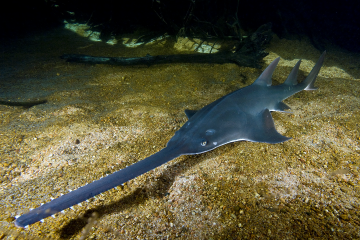710624_'Fishy' Teeth_360 px width.png

A modern-day sawfish. Teeth from a fossilized sawfish provided evidence for the evolution of teeth for all animals. Credit: Simon Fraser University, CC BY-SA 2.0.
When you bite into a chewy bagel, crunch a crispy taco, or grind up a piece of tough meat, you’re using structures that evolved hundreds of millions of years ago: teeth.
There’s no consensus on how teeth first formed. One idea says they formed from structures inside fish or perhaps other animals. The other says they formed from the scales of fish that resembled modern-day sharks—400 million years ago.
The scales of sharks and rays are made of a material similar to that found in teeth—theirs and ours. The scales of ancient sharks and rays were similar. Since the scales end around a fish’s mouth, that suggested that the scales basically “migrated” into fish mouths.
That would’ve provided a big advantage for the first fish with teeth. Early teeth were used to grab and hold prey, so a meal couldn’t simply wiggle away. The ability to chew came later.
A study released in late 2022 supports that “outside-in” idea of tooth evolution. Scientists studied the fossils of sawfish that lived 70 million years ago. They used an electron microscope to scan the scales that form the “spikes” on the edge of the fish’s long snouts. And they found that the material inside the spikes was basically the same as the enamel in modern teeth. The researchers suggested that it wouldn’t be a big step for true teeth to evolve from those scales.
The origin of teeth is still far from settled. But if they came from fish scales, then we have something in common with sharks.

